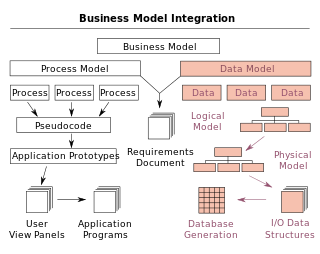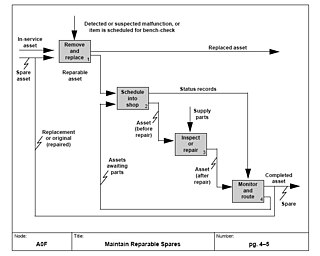
Software architecture is the set of structures needed to reason about a software system and the discipline of creating such structures and systems. Each structure comprises software elements, relations among them, and properties of both elements and relations.

A data model is an abstract model that organizes elements of data and standardizes how they relate to one another and to the properties of real-world entities. For instance, a data model may specify that the data element representing a car be composed of a number of other elements which, in turn, represent the color and size of the car and define its owner.

A system context diagram in engineering is a diagram that defines the boundary between the system, or part of a system, and its environment, showing the entities that interact with it. This diagram is a high level view of a system. It is similar to a block diagram.
Structured Systems Analysis and Design Method (SSADM) is a systems approach to the analysis and design of information systems. SSADM was produced for the Central Computer and Telecommunications Agency, a UK government office concerned with the use of technology in government, from 1980 onwards.

Data modeling in software engineering is the process of creating a data model for an information system by applying certain formal techniques. It may be applied as part of broader Model-driven engineering (MDD) concept.

The Zachman Framework is an enterprise ontology and is a fundamental structure for enterprise architecture which provides a formal and structured way of viewing and defining an enterprise. The ontology is a two dimensional classification schema that reflects the intersection between two historical classifications. The first are primitive interrogatives: What, How, When, Who, Where, and Why. The second is derived from the philosophical concept of reification, the transformation of an abstract idea into an instantiation. The Zachman Framework reification transformations are: identification, definition, representation, specification, configuration and instantiation.
Enterprise architecture (EA) is a business function concerned with the structures and behaviours of a business, especially business roles and processes that create and use business data. The international definition according to the Federation of Enterprise Architecture Professional Organizations is "a well-defined practice for conducting enterprise analysis, design, planning, and implementation, using a comprehensive approach at all times, for the successful development and execution of strategy. Enterprise architecture applies architecture principles and practices to guide organizations through the business, information, process, and technology changes necessary to execute their strategies. These practices utilize the various aspects of an enterprise to identify, motivate, and achieve these changes."

The Open Group Architecture Framework (TOGAF) is the most used framework for enterprise architecture as of 2020 that provides an approach for designing, planning, implementing, and governing an enterprise information technology architecture. TOGAF is a high-level approach to design. It is typically modeled at four levels: Business, Application, Data, and Technology. It relies heavily on modularization, standardization, and already existing, proven technologies and products.

The Department of Defense Architecture Framework (DoDAF) is an architecture framework for the United States Department of Defense (DoD) that provides visualization infrastructure for specific stakeholders concerns through viewpoints organized by various views. These views are artifacts for visualizing, understanding, and assimilating the broad scope and complexities of an architecture description through tabular, structural, behavioral, ontological, pictorial, temporal, graphical, probabilistic, or alternative conceptual means. The current release is DoDAF 2.02.
Business analysis is a professional discipline focused on identifying business needs and determining solutions to business problems. Solutions may include a software-systems development component, process improvements, or organizational changes, and may involve extensive analysis, strategic planning and policy development. A person dedicated to carrying out these tasks within an organization is called a business analyst or BA.
Data architecture consist of models, policies, rules, and standards that govern which data is collected and how it is stored, arranged, integrated, and put to use in data systems and in organizations. Data is usually one of several architecture domains that form the pillars of an enterprise architecture or solution architecture.

An enterprise architecture framework defines how to create and use an enterprise architecture. An architecture framework provides principles and practices for creating and using the architecture description of a system. It structures architects' thinking by dividing the architecture description into domains, layers, or views, and offers models – typically matrices and diagrams – for documenting each view. This allows for making systemic design decisions on all the components of the system and making long-term decisions around new design requirements, sustainability, and support.

Enterprise modelling is the abstract representation, description and definition of the structure, processes, information and resources of an identifiable business, government body, or other large organization.
Software Quality Management (SQM) is a management process that aims to develop and manage the quality of software in such a way so as to best ensure that the product meets the quality standards expected by the customer while also meeting any necessary regulatory and developer requirements, if any. Software quality managers require software to be tested before it is released to the market, and they do this using a cyclical process-based quality assessment in order to reveal and fix bugs before release. Their job is not only to ensure their software is in good shape for the consumer but also to encourage a culture of quality throughout the enterprise.
Capability management is a high-level management function, with particular application in the context of defense.
In information systems, applications architecture or application architecture is one of several architecture domains that form the pillars of an enterprise architecture (EA).

In systems engineering, software engineering, and computer science, a function model or functional model is a structured representation of the functions within the modeled system or subject area.

A view model or viewpoints framework in systems engineering, software engineering, and enterprise engineering is a framework which defines a coherent set of views to be used in the construction of a system architecture, software architecture, or enterprise architecture. A view is a representation of the whole system from the perspective of a related set of concerns.

The Treasury Information System Architecture Framework (TISAF) is an early 1990s Enterprise Architecture framework to assist US Treasury Bureaus to develop their Enterprise Information System Architectures (EISAs).

TRAK, or The Rail Architecture Framework, is a general enterprise architecture framework aimed at systems engineers. It is based on MODAF 1.2.





















